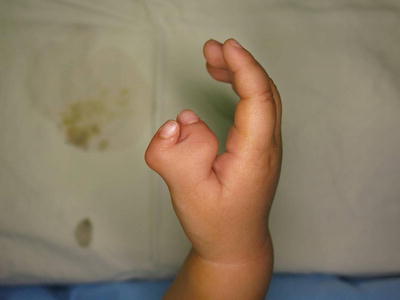Type 1: A bifid distal phalanx with a common epiphysis that articulates with a normal proximal phalanx
There may be one common nail, but usually there are two distinct nails with a groove between them
Type 2: A completely duplicated distal phalanx
Each distal phalanx usually has its own epiphysis that articulates with the normal proximal phalanx
Type 3: A duplicated distal phalanx with a bifurcated proximal phalanx
The distal phalanges usually diverge from the longitudinal axis, or they may be parallel
Type 4: A complete duplication of the proximal phalanx
Each proximal phalanx has its own epiphysis or a common epiphysis that articulates with a normal metacarpal or a metacarpal slightly widened to accommodate both proximal phalanges
Type 5: A bifurcated first metacarpal
Each head of the bifurcation articulates with a duplicated proximal phalanx which has its own epiphysis
Type 6: Complete duplication of the entire first digit
One side may be more rudimentary than the other
Type 7: A triphalangeal thumb or elements of a triphalangeal thumb accompanied by a normal thumb
The Wassel classification is based on an assessment of the skeleton. In young children whose skeleton is immature, the true nature of the thumbs may not be apparent. For instance, Wassel type 1 polydactyly can be classified as a type 2 until ossification of the distal phalangeal epiphysis becomes apparent [13]. Wassel type 7 polydactyly which has a triphalangeal component shows diverse manifestations, and is further subclassified into six types [8].
There are some types of radial polydactyly unclassifiable by the Wassel system. Pedunculated type, triplicated thumb, and extra-thumb, which do not have bony connection with the main thumb, cannot be classified.
Temtamy and McKusick classified radial polydactyly into four types—thumb polydactyly (type I), polydactyly of a triphalangeal thumb or opposable triphalangeal thumb (type II), polydactyly of an index finger or nonopposable triphalangeal thumb (type III), and polysyndactyly (type IV) [4].
Chung et al. proposed a new classification system based on the anatomic morphology at the origin of the extra digit [14]. Type I was defined as the joint type, where the extra digit has its own joint at its origin. In type II, the single epiphyseal type, the extra digit originates from the epiphysis directly. Type III, or osteochondroma-like type, originates from the metacarpal or phalangeal shaft of the main digit. Type IV is a hypoplastic type in which there is no bony connection between two thumbs. This classification system is practical and closely related to the surgical strategies.
Preoperative Evaluation
Sufficient discussion and explanation to the parents who have a baby with radial polydactyly on its clinical features and surgical outcome is necessary to maintain good rapport after the surgery. It is very important to inspect both hands of the patient, when a baby with radial polydactyly and his/her parents visit the outpatient department (OPD). Most of the babies with unilateral involvement show smaller sizes of affected thumbs than those of contralateral normal thumbs. Thus, the parents should understand that even if the more dominant one is preserved in the affected thumb, it will be smaller in length and girth when compared to the unaffected side.
In babies with bilateral involvement, the nail size of index finger can be a reference to judge the size of the affected thumbs. The width of the index fingernail is about two-thirds of that of the thumb in normal babies.
Active motion of each joint is hard to observe because the babies usually clench their hands. Passive motion and varus and valgus stress tests of the joints, palpation of tendons (especially flexor tendons), and observation of skin crease may be helpful to evaluate the polydactylic thumbs. Little or absent passive motion at bifurcation site of minor thumb (usually the radial one) may suggest odd-numbered Wassel type 1, 3, or 5. It is much easier to reconstruct a thumb that has stable joints in radioulnar plane. If the flexor tendon is palpable while moving the joint passively, good active motion can be expected postoperatively. When the skin crease is faint or absent, there is a strong possibility that the affected joint does not have effective motor power or the joint is fused, as in symphalangism.
Simple radiographs are very helpful for Wassel typing and surgical planning. Although it is not easy to obtain a true PA and lateral view of the affected thumbs, it is absolutely necessary for surgical planning. Radiographs of normal side in unilateral cases are also very important in assessing the size and shape of bones and joints of the affected thumbs comparatively. Medical photos are also needed for documentation and later evaluation of surgical outcome.
Before surgery, the parents should be informed that even if the thumb is reconstructed successfully, it will not be the same as the contralateral normal thumb in terms of function and cosmesis. The patients and their parents sometimes complain of applying a long arm cast postoperatively. However, a short arm cast can be easily removed spontaneously especially in young children.
In a study of 66 years of experiences for surgery of the duplicated thumb [15], there were 27.94 % of patients with serious complications, 7.35 % of them unsalvageable by secondary surgery, and 20.59 % salvageable by secondary surgery. Recently, the complication rates are declining. When initial surgery was planned to restore all anatomic elements, the need for secondary surgery was quite unusual [16]. The primary issues affecting appearance after surgery for radial polydactyly were reduced nail width and angulation at interphalangeal joint. Reconstructed Wassel type 7 thumbs had lower satisfaction score than other types [17].
Timing of Surgery
There has been no general agreement on proper timing of operation for radial polydactyly. Kozin recommended performing surgery at about 1 year of age, before the development of thumb-index finger pinch [18]. Jobe recommended performing surgical reconstruction when the child is about 18 months old, but no later than 5 years old, if possible [19]. Indebted to recent advancement in pediatric anesthesia, most surgeries can be performed safely if the patient does not have serious associated problems such as severe cardiac anomaly or pancytopenia. In certain cases, Wassel type 7, for example, bony shape of the delta bone is sometimes very important for surgical planning in which the surgical timing is better to be postponed until it is clearly visible in radiographs. Thus, timing of surgery depends on general condition of the patient, priority of surgery in patients with multiple associated anomalies, types of radial polydactyly, and most importantly surgeon’s judgement. There is no gold standard for surgical timing of radial polydactyly. However, earlier surgery is recommended when surgical planning is completed and the structures of the thumb are large enough to manipulate surgically.
Surgical Technique
The surgical goal for reconstruction of the radial polydactyly is to make a straight, mobile, and stable thumb of good appearance in size and shape. However, even after a successful reconstruction, the reconstructed thumb is not perfect in terms of function and cosmesis. We are trying to make a better thumb in a given situation, not the best or perfect thumb.
The patients with radial polydactyly show very diverse manifestations, from a rudimentary floating type to a complex one. Ligation or simple excision may be enough for floating types of radial polydactyly. However, simple ablation of one digit has not produced satisfactory outcomes in most cases of radial polydactyly and it has resulted in retained deviation, stiffness, and/or ligamentous instability of the thumb. Although surgical concepts and techniques are still evolving, there are several reconstructive strategies to achieve a functionally and cosmetically acceptable thumb.
Surgical techniques to reconstruct radial polydactyly can be classified into five types—ligation, simple excision, excision and reconstruction, combination procedures (Bilhaut-Cloquet operation), and on-top plasty.
The surgical wound is usually closed with absorbable 4-0 or 5-0 sutures. If the wound is closed with nonabsorbable sutures, sedation of the patients may be needed for removal of sutures. A long arm thumb spica cast with more than 90° of elbow flexion is recommended postoperatively, because a short arm thumb spica cast or a long arm cast in a position of a less flexed elbow can be easily taken off. Patients undergoing corrective osteotomy and/or reconstruction of collateral ligament should be immobilized for 4–6 weeks, depending on age. Postoperative physical therapy is not necessary in most patients.
Ligation
In a pedunculated type of radial polydactyly (Fig. 19.1), ligation at the base as close as possible to its root with 5-0 or 6-0 nylon with or without local anesthesia can be performed at OPD or nursery. Ligated hypoplastic thumb is mummified and usually falls off within 2 weeks. A nubbin usually remains after fall off. When the skin bridge measures more than 4 mm, excision under general anesthesia is recommended [13]. Even in the pedunculated type of polydactyly, painful neuroma may develop after the ligation, which is an indication for surgical exploration [20].
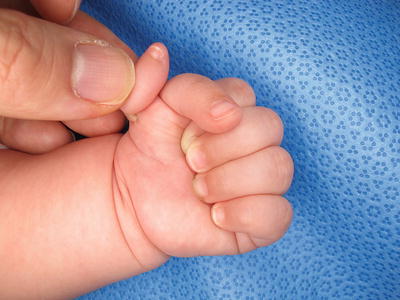

Fig. 19.1
A pedunculated type of radial polydactyly
Simple Excision
Simple excision under general anesthesia is indicated, when there is no bony connection between two polydactyly thumbs, and a dominant thumb shows good stability, motion, and alignment (Fig. 19.2).
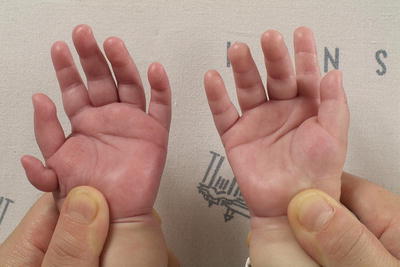

Fig. 19.2
When there is no bony connection between two thumbs, simple excision is indicated
Technique: An elliptical incision is made around the minor thumb. The soft tissue pedicle usually contains neurovascular structures. To avoid bleeding, the vessels should be ligated or cauterized. To prevent painful neuroma, the nerve should be identified, sharply transected, and imbedded in the soft tissue.
Excision and Reconstruction
More than half of the patients with radial polydactyly can be successfully treated by the “excision and reconstruction” technique (Fig. 19.3). Main components of this technique are arthroplasty, corrective osteotomy, and tendon realignment. When one of the two polydactylic thumbs is well developed, and the other one less developed, this technique is indicated. However, when both polydactylic thumbs are hypoplastic, this technique results in a small thumb, which is sometimes smaller than the index finger. Surgical technique for Wassel types 1 and 2 is similar. Also, similar surgical technique can be applied to Wassel types 3, 4, 5, and 6. For the diversity of clinical features, surgical technique for Wassel type 7 should be individualized case by case.
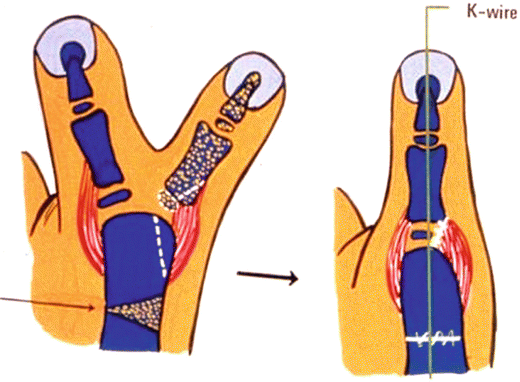

Fig. 19.3
A ligamentoperiosteal flap is raised to reconstruct the radial collateral ligament of the MP joint. The metacarpal head is excised partially to fit the base of the dominant proximal phalanx. If necessary, corrective osteotomy was added to make a straight thumb
Arthroplasty
Arthroplasty consists of two components, that is, joint stabilization by ligamentoperiosteal flap [21] and partial excision of excessive portion of phalangeal or metacarpal head on which two thumbs sit.
Two thumbs sit on a single proximal phalangeal head in Wassel type 1 or 2 radial polydactyly, and on a single metacarpal in type 3 or 4. During dissection of minor thumb, distal insertion of collateral ligament should be preserved with adjacent periosteal tissue for later reconstruction. This ligamentoperiosteal flap will be reattached to the base of the phalangeal bone of the remaining main thumb after removal of the minor thumb. The phalangeal or metacarpal head, when the minor thumb is removed, is relatively large for the remaining dominant thumb. This size mismatching between two bones may cause angular deformity and/or bony prominence if it is not corrected. Thus, excessive portion of the head needs to be shaved or removed. Sometimes, a separate facet that articulates with the radial thumb to be deleted is observed. This facet can be used as a guideline to cut the excessive portion. An oscillating saw or osteotome cannot be used for very small phalangeal bones of young children. Their phalangeal bones are soft enough that shaving of articular cartilage and partial ostectomy can be performed by a small rongeur or a surgical blade. Excessive tension of the reconstructed collateral ligament to correct angular deformity at the joint level is not recommended because the deformity is likely to recur and stiffness of the joint may occur. However, angular deformity of less than 10° at the joint level can be corrected by this arthroplasty procedure. A longitudinal Kirschner wire (K-wire) is inserted to protect the reconstructed collateral ligament.
Corrective Osteotomy
Angulation at interphalangeal joint and reduced nail width are primary issues affecting appearance after the surgery [17]. More than 20° of angular deformity is not acceptable to most patients and parents. This can be corrected by closing wedge osteotomy. Double level osteotomy at proximal phalangeal and metacarpal levels can be indicated to align a severe divergent-convergent Wassel type 4.
Tendon Realignment
Abnormal insertions of flexor pollicis longus (FPL) and/or extensor pollicis longus (EPL) are not uncommon in radial polydactyly, especially in Wassel type 4. The FPL tendon attaches not only at its customary insertion, but also into the extensor by a tendon that passes around the radial aspect of the thumb. This anomalous muscle abducts the thumb instead of flexion, and is called as “pollex abductus” [22, 23]. The abnormal insertion of FPL and/or EPL may cause gradual angular deformity even after successful bony alignment has been achieved by corrective osteotomy. If there are abnormal insertions of FPL and/or EPL tendons, the insertion sites should be realigned to achieve good flexion-extension arc. The abnormal insertion can be completely detached and reattached into the correct position. The tendon can be sutured into the distal phalanx of young children using 4-0 or 5-0 nylon. When the phalangeal bone is too hard to be sutured by nylon suture, a pull-out suture technique can be used. When the distal portion of the tendon is bifid and inserted into both polydactylic thumbs, it usually inserts at ulnar side of the radial thumb, and radial side of the ulnar thumb. If the radial thumb is to be removed, the tendon is detached from the insertion of radial thumb and reattached into the ulnar side of dominant ulnar thumb in a “Y” shape to balance the vector forces (Figs. 19.4 and 19.5). During this procedure, the portion of tendinous insertion into the radial side of the remaining radial thumb needs to be detached to avoid abnormal abduction force.
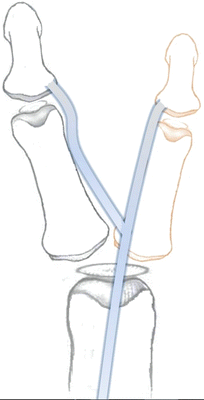


Fig. 19.4
The tendons frequently bifurcated distal to the MP joint, and insert to the side of each distal phalanx

Fig. 19.5
The tendon insertion of minor thumb is detached and reattached to the main thumb in a Y shape to balance the vector force
In Wassel type 4, 5, 6, or 7 polydactyly of the thumb, some of thenar muscles insert into the radial side thumb. In most cases, the radial thumb is removed and the ulnar thumb is reconstructed. The insertion site of thenar muscles on radial thumb should be identified and dissected carefully for later reattachment to the main ulnar thumb.
Surgical Technique (Wassel Type 1)
A 7-month-old girl showed radial polydactyly on right thumb (Fig. 19.6). The nail size, length, and girth of ulnar side thumb of left hand were good enough to perform the “excision of radial thumb and reconstruction” procedure. As the epiphyses of phalanges and metacarpal were not observed in simple radiograph (Fig. 19.7), it was hard to assess the exact Wassel type but easy to decide the surgical plan as “arthroplasty” with or without “tendon realignment.” Corrective osteotomy was not necessary because angular deformity at the IP joint is minimal. A racquet-shaped incision was designed. A zigzag incision has an advantage to prevent possible scar contracture, but this technique is not easy to apply to an infant with a thumb less than an inch in length. During dissection, it was confirmed that base of two distal phalanges was fused to be Wassel type 1. The dissection was deepened to expose distal phalangeal bone of the radial thumb, and a ligamentoperiosteal flap was raised. Distal phalanx of the radial thumb was cut to be removed, and the articular surface of this radial thumb was seen. Articular surface for the radial thumb was cut using a number-15 blade scalpel (Fig. 19.8). The consistency of phalangeal bone in an infant is soft enough to be cut by surgical blade. There was no misalignment of tendons. After the arthroplasty procedure, the articular surface of the proximal phalanx fits that of the ulnar thumb. Before reconstruction of the collateral ligament, a 0.7-mm K-wire was inserted longitudinally to protect it. The ligamentoperiosteal flap was attached to the new insertion site by 5-0 absorbable suture, reconstructing the collateral ligament (Fig. 19.9). The reconstructed thumb looked straight (Fig. 19.10).
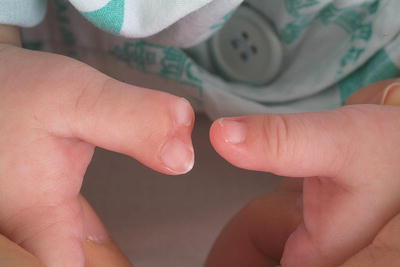
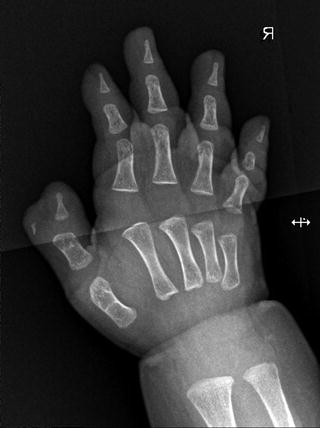
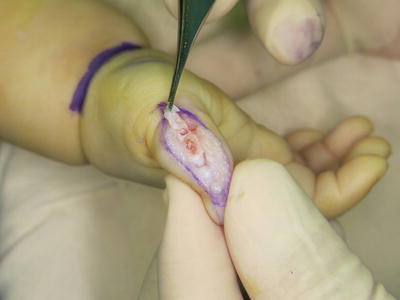
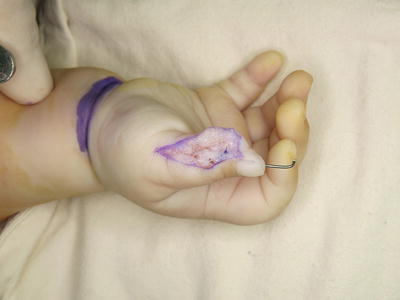
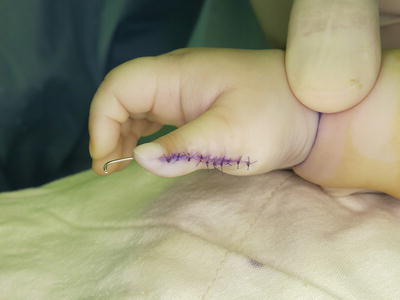

Fig. 19.6
Wassel type 1 polydactyly of right thumb. Ulnar thumb showed better configuration

Fig. 19.7
Two thumbs sit on the proximal phalangeal head, and the head showed enlargement

Fig. 19.8
A ligamentoperiosteal flap was raised (forcep), and the excessive portion of the proximal phalangeal head was removed

Fig. 19.9
A K-wire was inserted longitudinally, and the flap was reattached to the new insertion site

Fig. 19.10
Immediate postoperative finding
Surgical Technique (Wassel Type 4)
A 14-month-old boy showed a divergent-convergent Wassel type 4 radial polydactyly on the right side. The radial thumb was hypoplastic, but the ulnar thumb showed good size and shape (Fig. 19.11). There was 35° of angular deformity at the IP joint of ulnar thumb that needed corrective osteotomy at the proximal phalangeal neck level (Fig. 19.12). Medical photos and simple radiographs suggested strong possibility that arthroplasty of MP joint and tendon realignment of EPL, FPL, and thenar muscles were necessary for proper reconstruction. The proximal phalangeal head of the ulnar thumb was underdeveloped, suggesting a potential recurrence of angular deformity postoperatively. A racquet-shaped incision was designed (Fig. 19.13). The EPL tendon was bifurcated at MP joint level, and inserted into both thumbs (Fig. 19.14). The insertion site of radial EPL slip was detached and sutured to the ulnar side of dominant thumb to balance the extension force. The FPL tendon showed the same pattern (Fig. 19.15). The insertion of the radial FPL slip was detached and tagged with suture for later reattachment into the ulnar side of dominant thumb (Fig. 19.16). The abductor pollicis brevis muscle insertion into the radial thumb was detached from the proximal phalangeal base for later reattachment into the reconstructed thumb. The radial thumb was removed, leaving ligamentoperiosteal flap for later reconstruction of the MP joint. The portion of metacarpal head to be resected was lined (Fig. 19.17), and a ligamentoperiosteal flap was raised and preserved. Excessive articular cartilage and bone was resected by number 15 blade and small osteotomes. The author finds that it is very difficult to do a fine osteotomy with power instruments like an oscillating saw. The ligamentoperiosteal flap and detached abductor pollicis brevis tendon were preserved for later reattachment (Fig. 19.18). The proximal phalanx was dissected subperiosteally for ulnarly based closing wedge osteotomy to correct angular deformity at the IP joint (Fig. 19.19). It is convenient to perform ulnarly based closing wedge osteotomy from a separate ulnar side incision. However, simultaneous medial and lateral incision on the same thumb may jeopardize blood circulation. The MP joint was fixed in a reduced position with a K-wire, and also osteotomy site of proximal phalanx was fixed with an additional K-wire (Fig. 19.20). Finally, the FPL tendon detached from the radial thumb was reattached into the ulnar side of reconstructed distal phalanx. The abductor pollicis brevis tendon detached from radial thumb as well as the previously raised ligamentoperiosteal flap for collateral ligament reconstruction was also reinserted into the base of proximal phalanx (Fig. 19.21). Alignment and appearance of the reconstructed thumb (Fig. 19.22) and the immediate postoperative radiograph (Fig. 19.23) showed good result.

